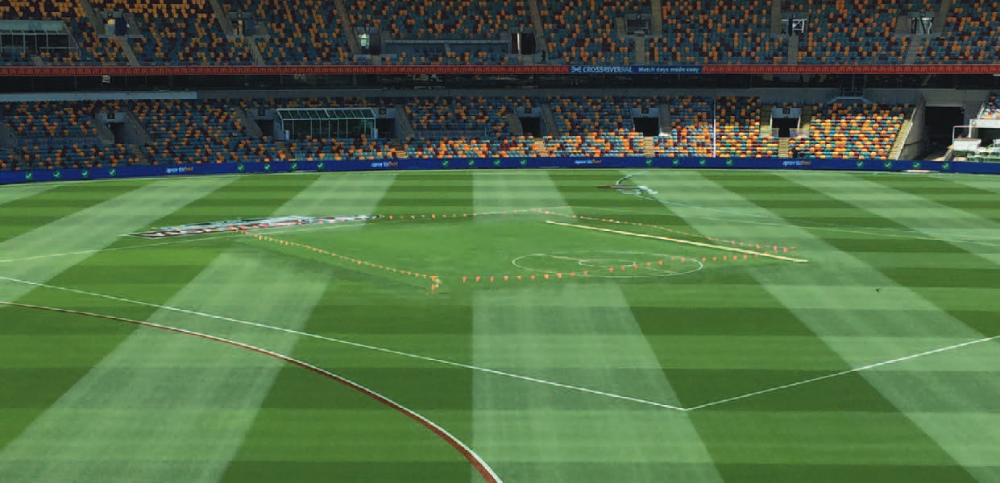How to Protect Your Turf During the Summer Holiday Period
At the end of each calendar year we have our Christmas / New Year holiday period. In particular that period is a time where we try to take a breath, enjoy some festivities and relax the mind if we can. One area of challenge at this time is disease management, and the degree of comfort we have with measures in place often affects the peace of mind we can potentially achieve.

Now not all sportsfields receive significant fungicide applications. It’s often related to intensity of use, venue and function. The local public park may for example receive little, but the higher profile (elite sport) venues certainly do. Whilst this article may be more directed at those higher profile sites, the message and targeted use of fungicides described herein may actually be one area and time a common practice across all levels is considered. This article is themed on matching a fungicide option (strobilurins), to a period of time (Christmas / New year window), and certain environmental conditions (warmer, wetter, humid) that pose a greater risk to disease. A period of time turf managers are seeking a break, a time of possibly reduced staffing and vigilance, a period of time where weather can work against us.
To help though we have a class of chemistry that is well suited to assist, regardless of venue status – the Strobilurins. This is one of the times of year this group should be prominent in your disease management plans in your efforts to attain peace of mind. If they aren’t at the moment here’s your chance to include them.
The importance of the strobilurins in turf management
The strobilurins are a very important fungicide family for us turf managers. The preventative mind set of turf protection programs is both anchored, and strongly supported, by the strobilurins. We use them as foundations for solid annual programs and build around them to manage resistance, coverage and peace of mind. A lot of base line fungicide programs have these slotted first at specifically targeted points, then the remainder is built around them looking to get them representing no more than a third of total use rotating with alternate classes that themselves have windows of optimal use based on their own characteristics.
Like many plant protection products their genesis tracks back to nature. The family were isolated from wood rotting fungi, then tweaked and perfected to improve stability, spectrum and efficacy. Their activity spectrum is wider than most fungicide families – even getting into the oomycete family (e.g. Pythium) that is more commonly controlled by specialist fungicides. These are gold class performers but equally need gold class protection to ensure they are here for us for the long-term.
Using them for the long term
This family needs to be thought of as preventatives and should not be the ‘go to’ in curative situations unless in mixtures with faster acting partners. Partly this is because of speed of movement, partly because of differential sensitivity of spores and mycelium some pathogens have to these fungicides, partly because of the affinity these fungicides have for cuticle tissues that even if they moved in a translaminar manner across the leaf they rebind with fervor limiting the amount of ai accessible to infections within other tissue – and partly because they have a specific target site and risks for resistance are heightened when such fungicides are deployed into high population pressures. Resistance has always been flagged as a possible issue for this family.
The strobilurin mode of action is rather simple to explain (eventhough its quite complex in reality). We all need energy to get things done right? Well strobilurins strike at the heart of this principle for the fungi they treat. They interfere with processes leading up to the production of the critical molecule that gives energy (ATP) – so the fungi basically run out of fuel and just can’t sustain the activity of infection and growth. Progressively the fuel is drained and we see this as the cessation of infection and overcoming of their action with turf recovery. But emphasis is on the word ‘progressively’ as this is how they operate.
The draining of fuel is the what, so how about the why? Why is Strobilurin use (and lets specifically discuss Azoxystrobin here) suitable for the Christmas window? Because although we have been discussing the ‘family’, all members of the family aren’t quite the same. One of the differences relates to their comparative mobility. Azoxystrobin has the highly desirable combination of very broad spectrum, excellent longevity of function, and efficient root uptake when applied to the soil. Such an application allows ‘whole of plant’ protection. If we use this chemistry as a root application, the number of diseases being prevented and / or treated, and the potential duration of coverage all other things being equal, is significant and worth seeking in the holiday period.
As mentioned above the strobilurins don’t move with the speed of say the triazoles – this can be good and bad. Good if you use them properly i.e. before issues exist, bad if you have a raging infection and you apply well into the attack phase as you may be disappointed. Understanding this ensures expectations are appropriate and timing of use is optimized. If you have been following these notes throughout the year you will have seen Azoxystrobin use advocated in the days prior to the commencement of renovations. Those few days allow the soil reservoir to be generated and primed for the plants plumbing to draw upon. It allows this slower moving chemistry to enter the plant and begin dosing the full plant structures prior to, and throughout, the critical days of actual renovation works. If well timed then the duration of activity should also carry you through the early post renovation stabilization period till recovery is well under way – and you are on track to produce happy and healthy turf once again. That precise same model gets re-applied (pardon the pun) in this Christmas window. Just substitute out the words ‘renovation window’ and substitute in the ‘christmas window’. Apply beforehand, provide time, enjoy spectrum and duration of coverage, move on with assurance.
It is the understanding and appreciation of key behavioural traits of chemistries that allow turf managers to get maximum bang for their buck. At this time a lot of the bang is peace of mind. Knowing about differences in solubility, mobility, speed of movement and spectrum, as well as post application travel allows the sensible, effective and appropriate use of the tools available.
How Nuturf can help you
Nuturf stock straight strobilurin chemistries as well as combination products with triazole fungicides for even broader spectrum. We can assist with further technical advice in understanding the different attributes of the chemistries available, practical tips on the application process looking for optimization of treatments and further advice on relevance to renovations in terms of timings, scheduling and compatibility with other cultural practices.
















